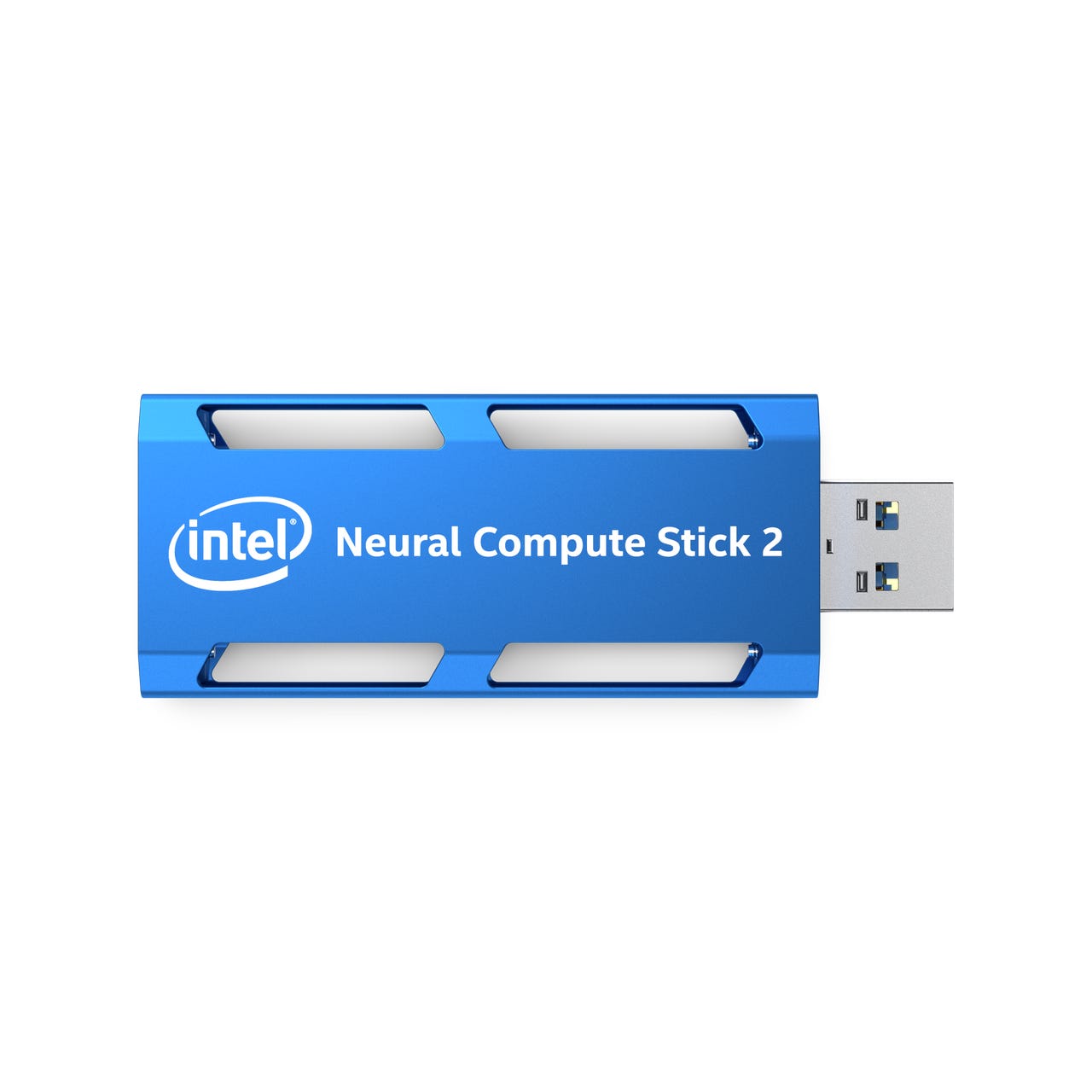Intel rolls out Neural Compute Stick 2


Featured
Intel on Wednesday is rolling out the Neural Compute Stick (NCS) 2, the second iteration of its popular self-contained AI accelerator. With this version, the NCS offers better performance, as well as scalability and a path to production.
The NCS comes in a USB format, making it easy to compile, tune and accelerate neural networks at the edge. No cloud connectivity is needed for its on-board processing. Developers and researchers can use it to seamlessly convert and deploy PC-trained computer vision models to a wide range of devices natively.
ZDNet: Black Friday 2018 deals: Business Bargain Hunter's top picks | Cyber Monday 2018 deals: Business Bargain Hunter's top picks
The NCS 2 is powered by the latest generation of Intel's vision processing unit (VPU), the Movidius Myriad X VPU, providing a performance improvement of up to 8X over the first NCS.
It's also supported by Intel's OpenVINO toolkit, which enables developers to build and train AI models in the cloud and deploy them across a broad range of products. This gives developers wide framework and network support, and even the flexibility to move models to more VPUs, a CPU, integrated graphics or FPGAs.
Meanwhile, with the Intel AI: In Production ecosystem, developers can port their Intel NCS 2 prototypes into production.
When Intel launched the first-generation NCS last year, it quickly sold out, Steen Graham, GM of IoT channels & ecosystem at Intel, told ZDNet.
CNET: Black Friday 2018: The best deals on sale right now | The best Black Friday deals of 2018: The Cheapskate's picks | Black Friday 2018 Amazon deals now available
"We've really had very little insight about what the demand was," Graham said. "A lot of people train models in the cloud, a lot of people do inference in the cloud -- but deploying deep learning or AI at the edge, we didn't know what the stage was in the deep learning community, what their interest was."
The popularity of the device aligns with trends bringing workloads to the edge, Graham said. According to IDC, 45 percent of data will be stored, analyzed and acted on at the edge by 2019. Intel's research, Graham said, says that by 2023, over 40 percent of AI tasks will take place on edge devices.
Since last year, tens of thousands of developers have deployed the NCS in a wide range of use cases. For instance, the sensor company Flir Systems recently launched the Firefly camera, a small piece of hardware that uses Intel's Movidius chips for on-camera inference. They used the NCS Neural Compute SDK to prototype the device.
TechRepublic: Black Friday 2018: Best deals for professionals | Adobe Creative Cloud gets 25% discount for Black Friday | A guide to tech and non-tech holiday gifts to buy online
Intel is highlighting ways developers have used the NCS to advance noble causes, such as detecting contaminated water in developing countries. Developer Peter Ma, who's backed by Intel, created a system called CleanWater AI to identify water bacteria using pattern recognition and machine learning. The system works with a digital microscope connected to a laptop running Ubuntu and the NCS. Contaminated sites can then be marked on a map.
Best gifts for co-workers under $50 on Amazon
Best Black Friday 2018 deals:
- Amazon Seven Days of Black Friday Deals: All-time lows on office devices
- Amazon Black Friday 2018 deals: See early sales on Echo, Fire HD
- Best Buy Black Friday 2018 deals: Deep discounts on Apple Mac, Microsoft Surface
- Costco Black Friday 2018 deals: $250 iPad, $200 laptops
- Staples Black Friday 2018 deals: PC sales include $150 Chromebook
- Target Black Friday 2018 deals: $250 iPad mini 4, $120 Chromebook
- BJs Black Friday 2018 deals: Laptop, desktop, and tablet sales galore
- Walmart Black Friday 2018 deals: $99 Chromebook, $89 Windows 2-in-1
- Dell Black Friday 2018 deals: $120 Inspiron laptop, $500 gaming desktop
- Jet Black Friday 2018 deals: $195 Roomba, $70 off Nest Cam Indoor
- Newegg Black Friday 2018 deals: $50 off Moto G6, $70 off Nest thermostat
- Office Depot Black Friday 2018 deals: $300 off Lenovo Flex, $129 HP Chromebook
- Sam's Club Black Friday 2018 deals: Buy a 4K TV and get a free Xbox One S
- eBay Black Friday 2018 deals: See early sales on Galaxy Watch, Chromecast
- Lenovo Black Friday 2018 deals: ThinkPad laptops and more
- Microsoft Store Black Friday 2018 deals: Ad showcases Surface, laptop deals
- Google Store Black Friday 2018 deals: Home Hub, Pixel 3, and Pixelbook
- HP Black Friday 2018 deals: Pavilion laptops, desktops
- Windows laptops Black Friday deals: Dell, HP, Lenovo
- Chromebook Black Friday 2018 deals: Dell, Google, HP
- Best tablet Black Friday deals: Apple iPad, Amazon Fire
- Black Friday 2018 iPhone deals: $400 iPhone X gift card, BOGO iPhone XR
- Black Friday 2018 smartphone deals: OnePlus 6T, LG G7